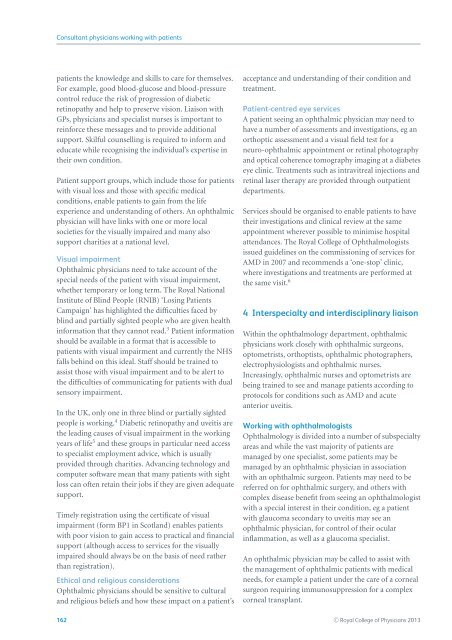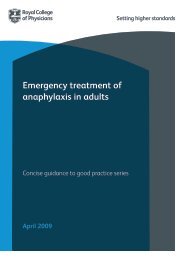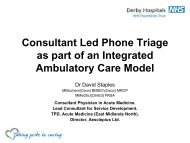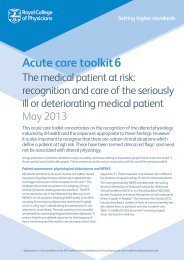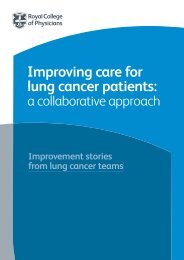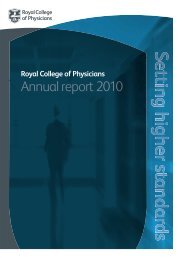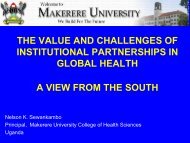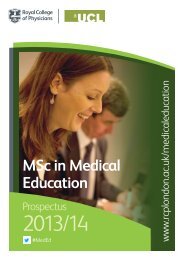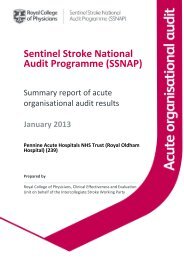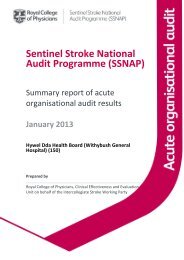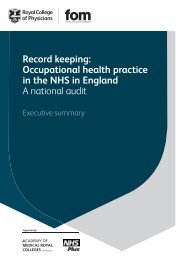Consultant physicians working with patients - Royal College of ...
Consultant physicians working with patients - Royal College of ...
Consultant physicians working with patients - Royal College of ...
You also want an ePaper? Increase the reach of your titles
YUMPU automatically turns print PDFs into web optimized ePapers that Google loves.
<strong>Consultant</strong> <strong>physicians</strong> <strong>working</strong> <strong>with</strong> <strong>patients</strong><strong>patients</strong> the knowledge and skills to care for themselves.For example, good blood-glucose and blood-pressurecontrol reduce the risk <strong>of</strong> progression <strong>of</strong> diabeticretinopathy and help to preserve vision. Liaison <strong>with</strong>GPs, <strong>physicians</strong> and specialist nurses is important toreinforce these messages and to provide additionalsupport. Skilful counselling is required to inform andeducate while recognising the individual’s expertise intheir own condition.Patient support groups, which include those for <strong>patients</strong><strong>with</strong> visual loss and those <strong>with</strong> specific medicalconditions, enable <strong>patients</strong> to gain from the lifeexperience and understanding <strong>of</strong> others. An ophthalmicphysician will have links <strong>with</strong> one or more localsocieties for the visually impaired and many alsosupport charities at a national level.Visual impairmentOphthalmic <strong>physicians</strong> need to take account <strong>of</strong> thespecial needs <strong>of</strong> the patient <strong>with</strong> visual impairment,whether temporary or long term. The <strong>Royal</strong> NationalInstitute <strong>of</strong> Blind People (RNIB) ‘Losing PatientsCampaign’ has highlighted the difficulties faced byblind and partially sighted people who are given healthinformation that they cannot read. 3 Patient informationshould be available in a format that is accessible to<strong>patients</strong> <strong>with</strong> visual impairment and currently the NHSfalls behind on this ideal. Staff should be trained toassist those <strong>with</strong> visual impairment and to be alert tothe difficulties <strong>of</strong> communicating for <strong>patients</strong> <strong>with</strong> dualsensory impairment.In the UK, only one in three blind or partially sightedpeople is <strong>working</strong>. 4 Diabetic retinopathy and uveitis arethe leading causes <strong>of</strong> visual impairment in the <strong>working</strong>years <strong>of</strong> life 5 and these groups in particular need accessto specialist employment advice, which is usuallyprovided through charities. Advancing technology andcomputer s<strong>of</strong>tware mean that many <strong>patients</strong> <strong>with</strong> sightloss can <strong>of</strong>ten retain their jobs if they are given adequatesupport.Timely registration using the certificate <strong>of</strong> visualimpairment (form BP1 in Scotland) enables <strong>patients</strong><strong>with</strong> poor vision to gain access to practical and financialsupport (although access to services for the visuallyimpaired should always be on the basis <strong>of</strong> need ratherthan registration).Ethical and religious considerationsOphthalmic <strong>physicians</strong> should be sensitive to culturaland religious beliefs and how these impact on a patient’sacceptance and understanding <strong>of</strong> their condition andtreatment.Patient-centred eye servicesA patient seeing an ophthalmic physician may need tohave a number <strong>of</strong> assessments and investigations, eg anorthoptic assessment and a visual field test for aneuro-ophthalmic appointment or retinal photographyand optical coherence tomography imaging at a diabeteseye clinic. Treatments such as intravitreal injections andretinal laser therapy are provided through outpatientdepartments.Services should be organised to enable <strong>patients</strong> to havetheir investigations and clinical review at the sameappointment wherever possible to minimise hospitalattendances. The <strong>Royal</strong> <strong>College</strong> <strong>of</strong> Ophthalmologistsissued guidelines on the commissioning <strong>of</strong> services forAMD in 2007 and recommends a ‘one-stop’ clinic,where investigations and treatments are performed atthe same visit. 64 Interspecialty and interdisciplinary liaisonWithin the ophthalmology department, ophthalmic<strong>physicians</strong> work closely <strong>with</strong> ophthalmic surgeons,optometrists, orthoptists, ophthalmic photographers,electrophysiologists and ophthalmic nurses.Increasingly, ophthalmic nurses and optometrists arebeing trained to see and manage <strong>patients</strong> according toprotocols for conditions such as AMD and acuteanterior uveitis.Working <strong>with</strong> ophthalmologistsOphthalmology is divided into a number <strong>of</strong> subspecialtyareas and while the vast majority <strong>of</strong> <strong>patients</strong> aremanaged by one specialist, some <strong>patients</strong> may bemanaged by an ophthalmic physician in association<strong>with</strong> an ophthalmic surgeon. Patients may need to bereferred on for ophthalmic surgery, and others <strong>with</strong>complex disease benefit from seeing an ophthalmologist<strong>with</strong> a special interest in their condition, eg a patient<strong>with</strong> glaucoma secondary to uveitis may see anophthalmic physician, for control <strong>of</strong> their ocularinflammation, as well as a glaucoma specialist.An ophthalmic physician may be called to assist <strong>with</strong>the management <strong>of</strong> ophthalmic <strong>patients</strong> <strong>with</strong> medicalneeds, for example a patient under the care <strong>of</strong> a cornealsurgeon requiring immunosuppression for a complexcorneal transplant.162 C○ <strong>Royal</strong> <strong>College</strong> <strong>of</strong> Physicians 2013


